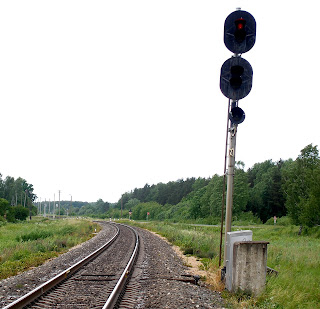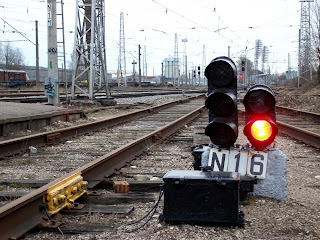Introduction
The Latvian signalling system was developed and introduced in the period of the former Union of Soviet Socialist Republics (USSR).
Therefore not only the Latvian railways are using this signalling system, but also the former members of the USSR like the baltic states and states in central asia.
This signalling system is described within signalling rules as common for railway operators. Within the signalling rules, the meaning of signal aspects and to some extent the required actions of a train driver are described.
Main and distant signals
Main signals can have signal heads with 2 or 3 signal lenses. For dwarf signals, the signal heads are arranged side by side. For signals on posts, the signal heads are aligned vertically. Signal heads of older types are shaped round, unlike newer types where the shape is more rectangular.
Entry signals
Entry signals are located at the station entry and are always on a post, expcept in cases of double line and wrong side entry. They are named with P or N and an additional letter in case of more then two entry signals.

Picture - Entry signal.
Exit and route signals
Exit signals are located in the station before the line and named with N or P and a following number normally telling the track number. Route signals are located in stations between entry and exit signals and named with N or P and a following letter. Both types can be on post or dwarf signals.
Beside the main signal aspects, exit and route signal can also show a signle white like shunting signals with the same meaning

Picture - Exit signals.

Picture - Dwarf exit signal.
Distant signals
Distant signals are used to announce the signal aspect of a following main signal. The are located in braking distance before the main signal and are named with "b" and the name of the announced signal, e.g. "bP".

Picture - Distant signal.
Block signals
Block signals are used to divide a line between station into block sections. Block signals are always named with even numbers in one direction and with odd numbers in the other direction, e.g. "14".
A special marking is used for block signals announcing entry signals, also the last block signal before the station. Such signals are marked by a diagonal black-white striped upper part of the signal post.

Picture - Block signal.
Signal aspects
red: Stop
green: Proceed
yellow: Proceed, expect stop
yellow-yellow: Proceed to side track, expect stop
flashing yellow-yellow: Proceed to side track, expect proceed
flashing yellow: Proceed, expect proceed to side track
yellow-yellow-green stripe: Proceed to side track at 80kph, expect stop
flashing yellow-yellow-green stripe: Proceed to side track at 80kph, expect proceed
flashing green: Proceed, expect proceed to side track at 80kph
flashing green-yellow-green stripe: Proceed to side track at 80kph, expect proceed to side track at 80kph
red-flashing white: Call-on signal
yellow-yellow-yellow: Short entry route
green-green: Proceed, route set in special direction
yellow-green: Proceed, reduce speed, next signal is in reduced braking distance and shows expect stop.
Signal indicators
Route indicators
Route indicators are simply switched on and off if a certain main route is set. They provide in addition to the main signal aspect further information to the train staff. Route indicators can be arranged below the main signal head or stand alone on a signal post. Stand-alone route indicators are named with "MR" and a following number.
Indication of direction
This indicator shows a line as direction or the name of a following station where the route leads to.
line or letter: Direction of set route

Picture - Stand-alone route indicator.
Indication of start track
This indicator shows for group exit or shunting signals for which track the signal aspect is meant.
green number: Track where signal aspect belongs to
Indication of dead-end entry
"S" letter: Route leads to dead end
Indication of electrified route
"E" letter: Route is electrified
Limited braking distance indicator
Limited braking distance indicators are used to indicate that the braking distance from this signal to the next signal is shorter then usual. This means that the train must reduce speed and brake more intensive as usual if running at maximum speed.
one arrow: Expect reduced braking distance
two arrows: Reduced braking distance

Picture - Indicator for expect reduced braking distance.

Picture - Indicator for reduced braking distance.
Conditionally permissive indicator
This indicator is used at block signals, where it is allowed for freight trains to pass the red signal at a low speed of 20kph. This is to avoid the stopping of the train before the signal, as such indicator is always used at block signal in steep grades, where it is problematic for a freight train to accelerate. The signal is a reflecting board.
board with "T": Red signal can be passed at 20kph
Repeating signals
Repeating signals are used to indicate the proceed aspect of an assigned exit signal if the signal sighting is insufficiant. After a train has stopped in an arrival-departure track, it is only allowed to continue to the exit signal if the repeater shows proceed.
no aspect: no meaning
green: Main signal in proceed

Picture - Repeating signals.

Picture - Repeating signals (with proceed aspect).

Picture - Combination of barrage and repeating signal.
Shunting signals
Shunting signals are used to allow or prohibit shunting movements. They are named with "M" and a following number. Most of shunting signals are dwarf signals, but also shunting signals on posts are used.
blue or red: "Shunting not allowed"
white: "Shunting allowed"
white-white: "Shunting with increased speed allowed, track is clear"

Picture - Dwarf shunting signal.

Picture - Shunting signal on post.
Barrage signals
Barrage signals are used to protect special locations, especially level crossings with barriers. For level crossings, a level crossing guarc can set those signals to stop aspect if some problems at the level crossing occur. Sometime when those signals are used in protecting function within stations, they are also set to Stop if the level crossing is open. Barrage signals are named with "A" and a following number. The signal post is diagonal striped black and white.
no aspect: no meaning
yellow: Expect stop
red: Stop

Picture - Barrage signals.
Hot-Box signals
Hot-Box signals are used to indicate to the train driver that a hot box or wheel was detected at his train. Such signals are arranged at a distance of maximum train length (850 meters) behind a hot-box detector.
no aspect: no meaning
white "V": "Hot axle detected"

Picture - Hot-Box signal.
Signals for marking speed restrictions
Fix signal boards are used to mark zones with a speed restriction, e.g. because of worse track conditions or coming up civil structures like bridges. Like in many other railways, there are different signals for permanent and temporary speed restrictions.
yellow disc: "Expect permanent speed restricted zone"
disc with horizontal bar and speed sign: "Begin of speed restricted zone"
disc with rectangular bar: "End of speed restricted zone"
green disc: "Permanent speed restricted zone passed"

Picture - Yellow disc "Expect speed restriction".

Picture - Disc "Begin of speed restriction".

Picture - Disc "End of speed restriction".

Picture - Green disc "Speed restriction passed".
As temporary signals are used boards, that can easily be placed beside the track in the ballast:
yellow board: "Start of temporary speed restricted zone"
green board: "End of temporary speed restricted zone"

Picture - Yellow board "Start of temporary speed restriction"
Protecting signals
Such protecting signals are indicate that they cannot be passed by any tran or shunting movement. They are used for closed tracks, to mark buffer stops or derailers in derailing position
red board: "Stop"
circle with horizontal bar: "Stop"
circle with rectangular bar: "Derailer can be passed"
Catanary signals
"Be prepared to lower pantagraph"
"Lower pantagraph"
"Raise pantagraph"
Signals for marking borders and limits
Such signals for marking borders and limits on site are used by all railways to provide more and additional information and instructions to the train drivers.
Station limit
The station limit is where the station ends towards the open line and therefore where shunting movements are not protected by shunting routes any more. So all shunting movements must stop at this station limit. On signle lines, this station limit is simply marked by the post of the entry signal, but on double tracks, a board is used.
white board with inscription: Station limit

Picture - Board for station limit
Stop limit
A stop limit marks for trains where the locomotive or train unit must stop. Such signals are used to let a train stop aligned to a platform or to keep points in the arrival-departure tracks clear of a train. Normally, an inscription is telling more deatails about the rolling stock who shall stop before the board.
white board with inscription: Stop limit for ...

Picture - Board for stop limit
Fouling points
Fouling points are marked by all railways to indicate at what point the clearance of an adjacent track is fouled. In this signalling system, it is differentiated between tracks where regularely are trains running and tracks where only shunting movements take place.
white-black-white post: Fouling point at main tracks
black-white diagonal striped: "Point clearance for sidings"

Picture - Fouling point at main track.

Picture - Fouling point at side track.
Supervision points
Passing by trains are checked by station attendants or level crossing guards at certain places if some damage or irregularities can be seen. Especially on stations with semi-automatic block, where the end of train signal must be checked, these places are marked by a supervision signal. Here the train driver must also check if the station attendant is outside the building and watching the train.
yellow "!" mark: Point of train supervision

Picture - Board marking supervision point.
Kilometrage
Kilometrage is marked with boards and posts. They are not considered as real signals as they do not impose certain actions on train crew.

Picture - Board marking kilometer.

Picture - Post marking hectometer.
Whistle signals
At certain places, it is important to draw attention to an approaching train and warn people possibly walking close to the track or passing a level crossing. Places where a train must whistle are marked by a special signal board.
green-white board with S: "Whistle"

Picure - Whistle board.
Signals for snow ploughs
The snow plough cannot use his plough in lowered position at all places at sometime rail equipment or road surface at level crossings is higher then the rail head. To indicate those places, boards for snow ploughs are used.
half disc: Be prepared to raise snow plough
rectangle: Raise snow plough
triangle: Lower snow plough
two rectangles: Snow plough not allowed

Picture - Board "Be prepared to raise snow plough".
Picture - Board "Raise snow plough".
Picture - Board "Lower snow plough"
Picture - Board "Snow plough not allowed"